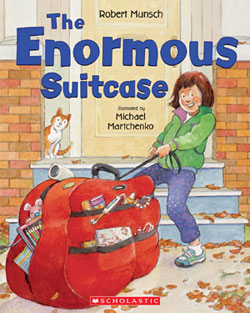| ________________
CM . . .
. Volume XXIV Number 7. . . .October 20, 2017

 |
The Enormous Suitcase.
Robert Munsch. Illustrated by Michael Martchenko.
Toronto, ON: North Winds Press/Scholastic Canada, 2017.
30 pp., hardcover, $19.99.
ISBN 978-1-4431-6318-7.
Preschool-grade 3 / Ages 4-8.
Review by Kristen Ferguson.
*** /4
|
| |
|

excerpt:
“You’re taking the picture right off the wall?” asked her mom.
“Yes,” said Kelsey. “I like this picture. I think I should live in one house and both of you should visit me, but that is not going to happen so I am taking my picture back and forth.”
“Well . . . okay,” said her mom.
I have a confession to make. I’m not a Robert Munsch fan, not either as a parent or as a teacher. When asked to review The Enormous Suitcase by Munsch and illustrated by Michael Martchenko, I kept an open mind, and I was pleasantly surprised. On the back cover of the book in Robert Munsch’s biography, it states that The Enormous Suitcase was “written for a girl who sent him a letter asking for a book about a girl who lives in two different houses.” There are types of diversity that often get overlooked in terms of representation in children’s books. As Munsch’s biography statement suggests, children who live with parents who are separated could be one such underrepresented group.
In The Enormous Suitcase, Kelsey rotates back and forth between living with her dad for a week and her mother the next. She decides she wants to take items of importance back and forth from house to house with her, including a picture, pillow, and even the dog. Since Kelsey knows her mom won’t let her take the dog, she packs the dog in the enormous suitcase and takes the bus to her father’s. She forgot, however, that her father has a cat. But her fears are alleviated when she finds the cat and the dog sleeping together. Kelsey’s dad states, “Isn’t it amazing how things can work out if you just try?” She then decides to bring the goldfish with her next time to her father’s house, but, instead of a peaceful friendship between the animals, the cat ate the goldfish. The Enormous Suitcase ends with, “Because it turns out that some things do not work out, no matter how hard you try.”
While The Enormous Suitcase has a somewhat abrupt ending, I feel like it represents the situation of many children who live in dual homes. As much as children want their parents to be happy and together, it is not the child’s job to make it so. Indeed, sometimes things do not work out. The story of the pets in The Enormous Suitcase provides a gentle and relatable situation for parents to talk with their children about separation, divorce, and living apart. As always, Marchenko’s illustrations are fun and delightful. My favourites are the illustrations of the other animals on the city bus and the last page that portrays the guilty looking cat and the goldfish skeleton.
The Enormous Suitcase would be suitable for ages four to eight and would make a good addition to home, classroom, and school libraries.
Recommended.
Dr. Kristen Ferguson teaches literacy education at the Schulich School of Education at Nipissing University in North Bay, ON.

© CM Association
CC BY-NC-ND
Hosted by:
University of Manitoba
ISSN 1201-9364
|
This Creative Commons license allows you to download the review and share it with others as long as you credit the CM Association. You cannot change the review in any way or use it commercially.
Commercial use is available through a contract with the CM Association. This Creative Commons license allows publishers whose works are being reviewed to download and share said CM reviews provided you credit the CM Association. |
Next Review | Table of Contents for This Issue - October 20, 2017.
CM Home | Back Issues | Search | CM Archive | Profiles Archive
|
